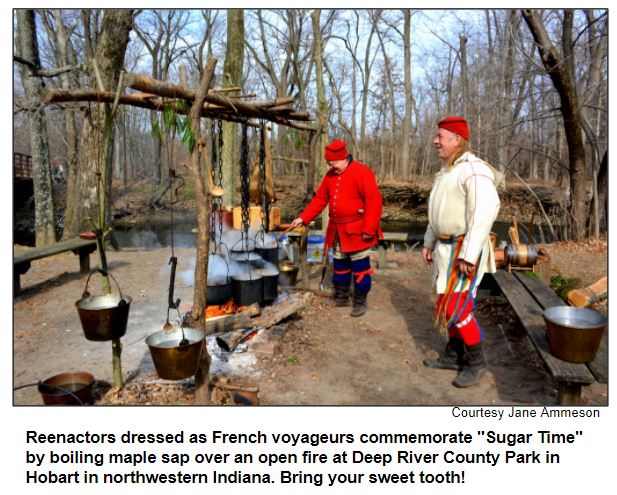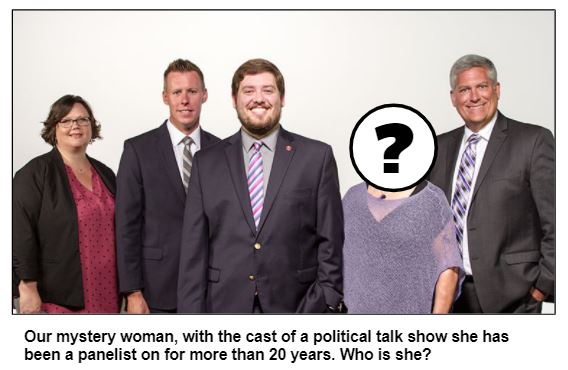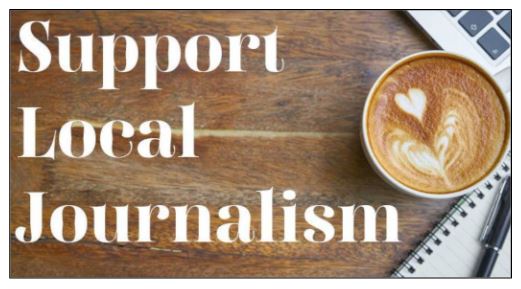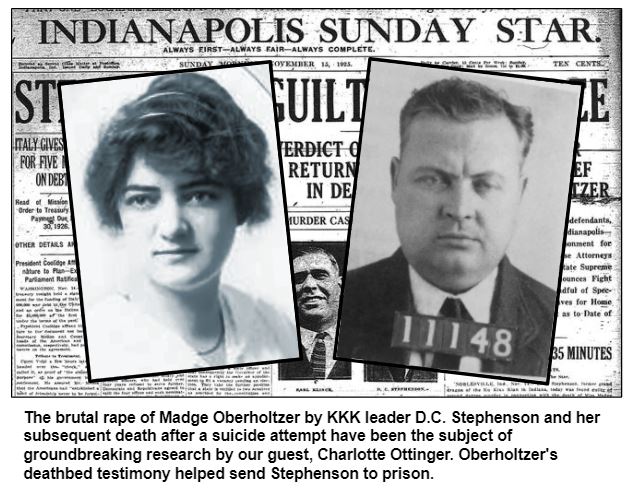Saturdays, noon to 1 p.m. ET on WICR 88.7 FM.
Or stream audio live from anywhere on WICR Online!
March 6, 2021
Women, the Indiana General Assembly and state officials
As Hoosier History Live salutes Women's History Month, we will explore a range of aspects associated with women who have served in the Indiana General Assembly and as state and federal officials from the Hoosier state.
What questions have been asked of women candidates for public office that have not been posed to their male counterparts? What's been the percentage of female lawmakers at the Indiana Statehouse? Why has Indiana's lieutenant governor frequently been a woman during the last 20 years, but a woman never has served as governor?

The latter issue was the focus of a column a few years ago by the acclaimed, retired political journalist who will be Nelson's guest in this show on women's history in Indiana. Beginning in 1991, Mary Beth Schneider covered every session of the General Assembly for the Indianapolis Star until 2013. She also covered national political conventions, presidential debates and the caucuses and primaries in Iowa, New Hampshire and other states.
During her career at the Star, which began in 1979, Mary Beth covered a variety of other beats and served as an assistant city editor; in 2019 and 2020, she wrote a weekly political column and edited stories for TheStatehouseFile.com, a news service run by Franklin College students.
According to state legislative records, women lawmakers make up about 21 percent of the current General Assembly. Of the nine members of the U.S. Congress from Indiana, two are women. Since 2003, when Gov. Joe Kernan appointed Kathy Davis, a Democrat from Indianapolis, as the first women lieutenant governor in Indiana's history (her successor, Becky Skillman, a Republican from Bedford, became the first woman elected to the position, serving two terms under Gov. Mitch Daniels), the state's No. 2 post has been held by a woman except for about nine months in 2016. That's when current governor Eric Holcomb had the job.
Not only hasn't a woman ever served as governor of Indiana, a woman has never been mayor of the state's largest city. Since 1995, three women have been nominated by the major political parties for mayor of Indianapolis, but all of them were unsuccessful. In 1999, Sue Anne Gilroy, a Republican, was defeated by Bart Peterson. Melina Kennedy, a Democrat who was deputy mayor under Peterson, lost her mayoral campaign in 2011 to incumbent Greg Ballard. Back in 1995, Z. Mae Jimison, a Democrat, also lost to the incumbent mayor, Steve Goldsmith.
When Gilroy ran her campaign for mayor, she was serving as Indiana's secretary of state. The current secretary of state also is a woman. Last month, Connie Lawson, a Republican from Hendricks County, announced she will be stepping down to, in her words, "focus on my health and my family."
Lawson, who has been in the post since 2012, is the longest-serving secretary of state in Indiana history. Before becoming secretary of state, she served for 16 years in the Indiana Senate. In 2006, Lawson made history by becoming the first woman to serve as a majority floor leader in the senate.
Some history facts:
- In 1920, the year that women achieved the right to vote with the ratification of the 19th Amendment, the first woman was elected to the Indiana legislature. She was Julia Nelson, a Republican from Muncie.
- The first woman elected to the U.S. Congress from Indiana was Virginia Jenckes, a Democrat from Terre Haute. Hoosier History Live discussed Jenckes, who was elected in 1932, during a show last March that focused on Hoosier women who advocated for suffrage.
- In a 2019 column for TheStatehouseFile.com, our guest Mary Beth Schneider noted that the second floor of the Indiana Capitol Building has seven busts, all of them men. All of the eight busts on the third floor also honor men except for one, a bust commemorating the late U.S. Rep. Julia Carson.
Roadtrip: "Sugar Time" in Deep River County Park and Chellberg Farm
With spring just around the corner, Guest Roadtripper and travel and food writer Jane Ammeson suggests we hit the road for "Sugar Time" - the age-old spring harvest of sap from maple trees and the boiling down of the sap into syrup.
First stop on this sweet Roadtrip: Deep River County Park in Hobart, where we'll witness a historic reenactment of the syrup-making process, with sap on the boil in a big iron kettle over an open fire. Park reenactors dressed like French voyageurs - those early explorers who paddled on the rivers and lakes of what we now call the Midwest - will explain how they learned to survive from Native Americans, eating what they could forage from the natural environment.
Also on the Deep River property is John Wood's Mill, dating back to the mid-1800s, which is typically open, wheels a-churning, during Sugar Time.
Next stop on our journey into maple sweetness: Chellberg Farm, a living history museum that tells the story of a Swedish homestead in what is now the Indiana Dunes National Park.
Bruce Rowe, public information officer at the park, explains that Native Americans tapped the many maple trees growing in the area, collecting the sap and pouring it into hollowed out logs and/or clay pots so it could be boiled down. The Chellbergs and other European settlers continued the practice of collecting sap and making syrup, but used metal pots and other equipment that made the process substantially easier.
Be sure to join Jane on this sweet dive into history!
History Mystery
In 1984, a well-known public figure in Indianapolis was the Democratic Party's unsuccessful candidate for lieutenant governor. An attorney, she had served as a deputy prosecutor in Marion County on several high-profile cases. In 1993, she became the first woman to chair the Democratic Party in Indiana.
For more than 20 years, she has been a panelist on a political talk show broadcast across the state. She also has been a civic leader in central Indiana and served as the executive director of a social service organization for 15 years.
Question: Who is she?
The call-in number is (317) 788-3314. Please do not call in to the show until you hear Nelson pose the question on the air, and please do not try to win if you have won any other prize on WICR during the last two months. You must be willing to give your first name to our engineer, you must answer the question correctly on the air and you must be willing to give your mailing address to our engineer so we can mail the prize pack to you.
The prizes this week are two tickets to the Indiana State Museum, courtesy of the Indiana State Museum, and two tickets to Indy's Teeny Statue of Liberty Museum, courtesy of Tim and Julie's Another Fine Mess.
We get by with a little help from our friends
Everyone could use a little help now and then, and Hoosier History Live is no exception.
If you are part of an organization or business that would like a promotional boost, please consider providing a prize for the weekly History Mystery feature of our show. The name of your organization or business will be posted on our online media, and you also get a mention during the live show by our host Nelson. Prizes must fit in a standard business envelope, such as tickets, passes or vouchers. Contact our producer Molly Head, molly@hoosierhistorylive.org, for more information.
We always strive to feature exciting new guests and intriguing topics on the show, but we'd love to get some fresh ideas from our listeners. If you have a suggestion for a featured guest or a main topic for a show, please reach out to Molly at the same email address posted above. Include "guest/show topic idea" in the email header. If you do propose a topic, you must include possible guests who could speak authoritatively about it, and their contact information. Include some notes to support your idea, too. Be aware that we do make our own editorial decisions.
As the danger of the pandemic passes and social distancing restrictions ease, we're also hoping to revive Hoosier History Live listening groups, and we are reaching out to volunteer organizers. The idea behind the listening groups is for people to gather on Saturdays a little before noon, listen to the live show and then discuss. It's a great social and educational opportunity for libraries, small businesses, and history and community centers. All you need is an organizer, a listening device such as a radio or a computer or phone hooked up to a speaker, and a quiet place with comfortable chairs. Again, contact Molly Head if you'd like help setting up a listening group.
And finally, we always appreciate your financial support. Our researchers, writers, editors, artists, and marketers are working hard to keep Hoosier History Live part of the intellectual life of our beloved Indiana, and we can't do it without you. You can visit the yellow Donate button on our website or newsletter to use a bank account or PayPal, or write a check to Hoosier History Live and send it to P.O. Box 44393, Indianapolis IN 46244-0393.
Thanks, friends, for helping to support local journalism!
Nelson Price, host and historian
Molly Head, producer/general manager, (317) 927-9101
Mick Armbruster, associate producer
Cheryl Lamb, administrative manager
Richard Sullivan, senior tech consultant
Pam Fraizer, graphic designer
Garry Chilluffo, consultant
Please tell our sponsors that you appreciate their support!

 For organizational sponsorship, which includes logos, links, and voiced credits in the show and in podcasts, email molly@hoosierhistorylive.org, or call (317) 927-9101 for information. Our podcast listens are increasing and we are being distributed on Indiana Memory and the National Digital Public Library. Grow with us as our podcast and internet presence expands! Thanks also to Visit Indy, Fraizer Designs, WICR-FM, Henri Pensis, Genesis Brown, Kielynn Tally, Heather McIntyre, Justin Clark, and many other individuals and organizations.
For organizational sponsorship, which includes logos, links, and voiced credits in the show and in podcasts, email molly@hoosierhistorylive.org, or call (317) 927-9101 for information. Our podcast listens are increasing and we are being distributed on Indiana Memory and the National Digital Public Library. Grow with us as our podcast and internet presence expands! Thanks also to Visit Indy, Fraizer Designs, WICR-FM, Henri Pensis, Genesis Brown, Kielynn Tally, Heather McIntyre, Justin Clark, and many other individuals and organizations.
Thank you!
We'd like to thank the following recent, new and renewal contributors whose donations help make this show possible!
- Kathleen Angelone
- Tim and Meg Shelly
- Connor & Company, Inc.
- Georgia Cravey and Jim Lingenfelter
- Ann Frick
- Yetta Wolen
- In memory of William G. "Bill" Mihay
- Dr. William McNiece
- Michael Freeland and Sharon Butsch Freeland
- David E. and Lynne J. Steele
- Stacia Gorge
- Margaret Smith
- Rachel Perry
- Tom and Linda Castaldi
March 13, 2021 - coming up
Madge Oberholtzer: more than victim of a shocking crime in 1925
She was the victim of one of the most lurid crimes in Indiana history, the brutal rape in March 1925 by D.C. Stephenson, Grand Dragon of the Ku Klux Klan, that led to her eventual death after a suicide attempt. The deathbed testimony of Madge Oberholtzer, a resident of the Irvington neighborhood of Indianapolis, resulted in the eventual conviction of Stephenson of second degree murder, a pivotal episode in the downfall of the Klan in Indiana during the 1920s.
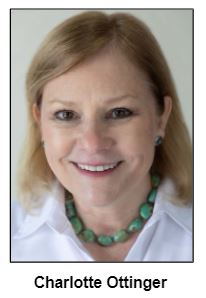
Charlotte, who is convinced Madge did not willingly go on the train trip, will be Nelson's guest to discuss her extensive research. She has interviewed four grandchildren of Madge's brother, who have given her family documents, photos and other artifacts never seen by the general public or used by other researchers. Some of the material is now in the archives of the Irvington Historical Society; Charlotte is a former board member.
There's even a Women's History Month aspect for our show. According to Charlotte's research into Madge's youth, she was mentored by several Indiana suffragists. Madge graduated from Manual High School in 1914 and attended Butler University, which then was Butler College and located in Irvington. According to Charlotte, the talent in painting and drawing that Madge displayed at Manual earned her scholarships to study at the Herron School of Art.
During our show, Charlotte will describe the impact of Madge's tragic death on her family. Madge's mother, Matilda Oberholtzer, was a short-term patient in a sanitarium in Martinsville after her daughter's death.
An American Sign Language medical interpreter as well as a nurse, Charlotte says her medical background helped her sort through the treatment provided to Madge, the autopsy results and the extensive medical testimony at Stephenson's sensational trial. After her brutal rape in Stephenson's private train car, Madge swallowed poison in a hotel room in Hammond.
Hoosier History Live has discussed the frightening power of Stephenson - who once declared "I am the law in Indiana" - during previous shows. They have included a show last September in which Nelson interviewed James Madison, author of The Ku Klux Klan in the Heartland (IU Press).








